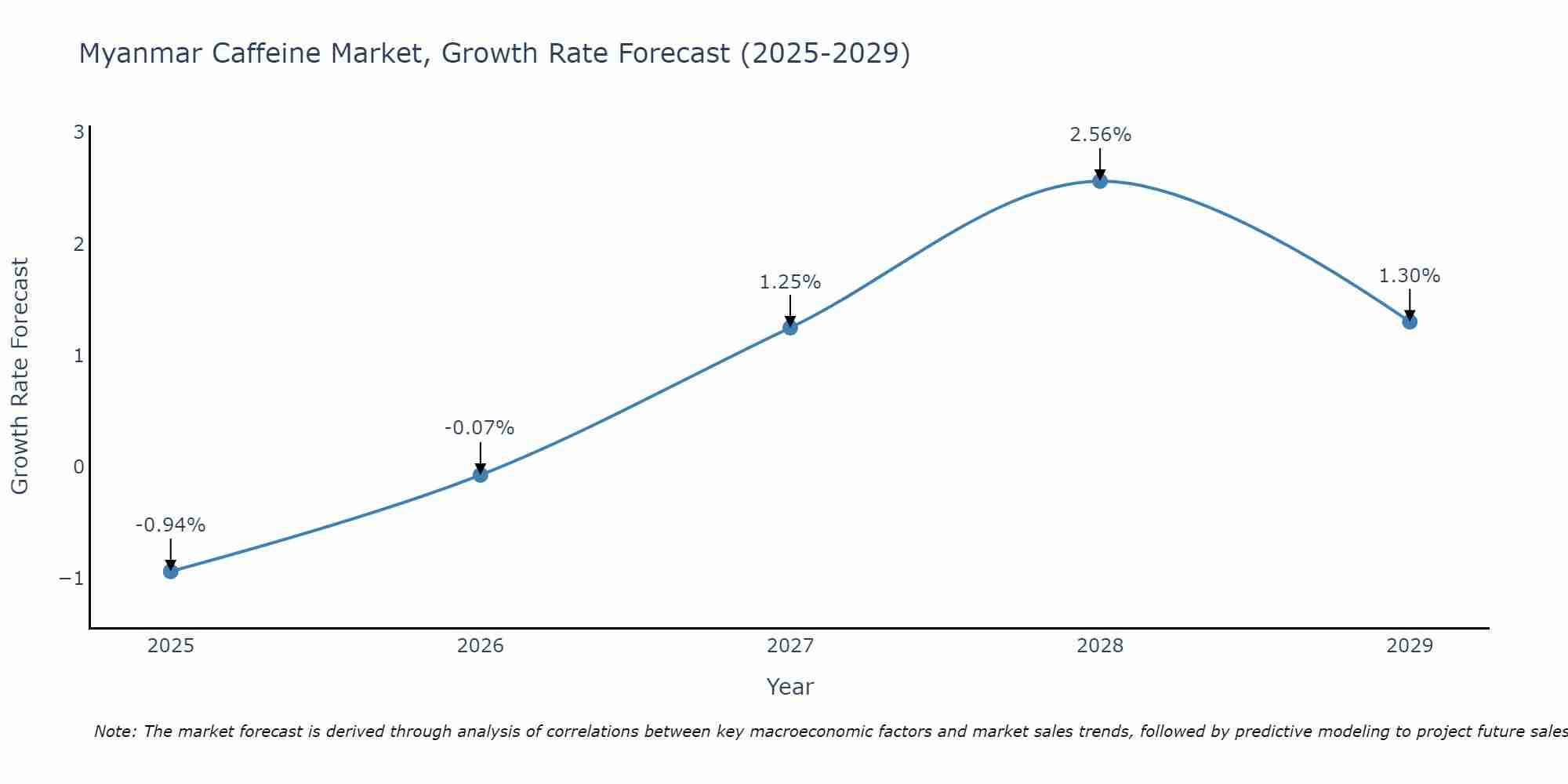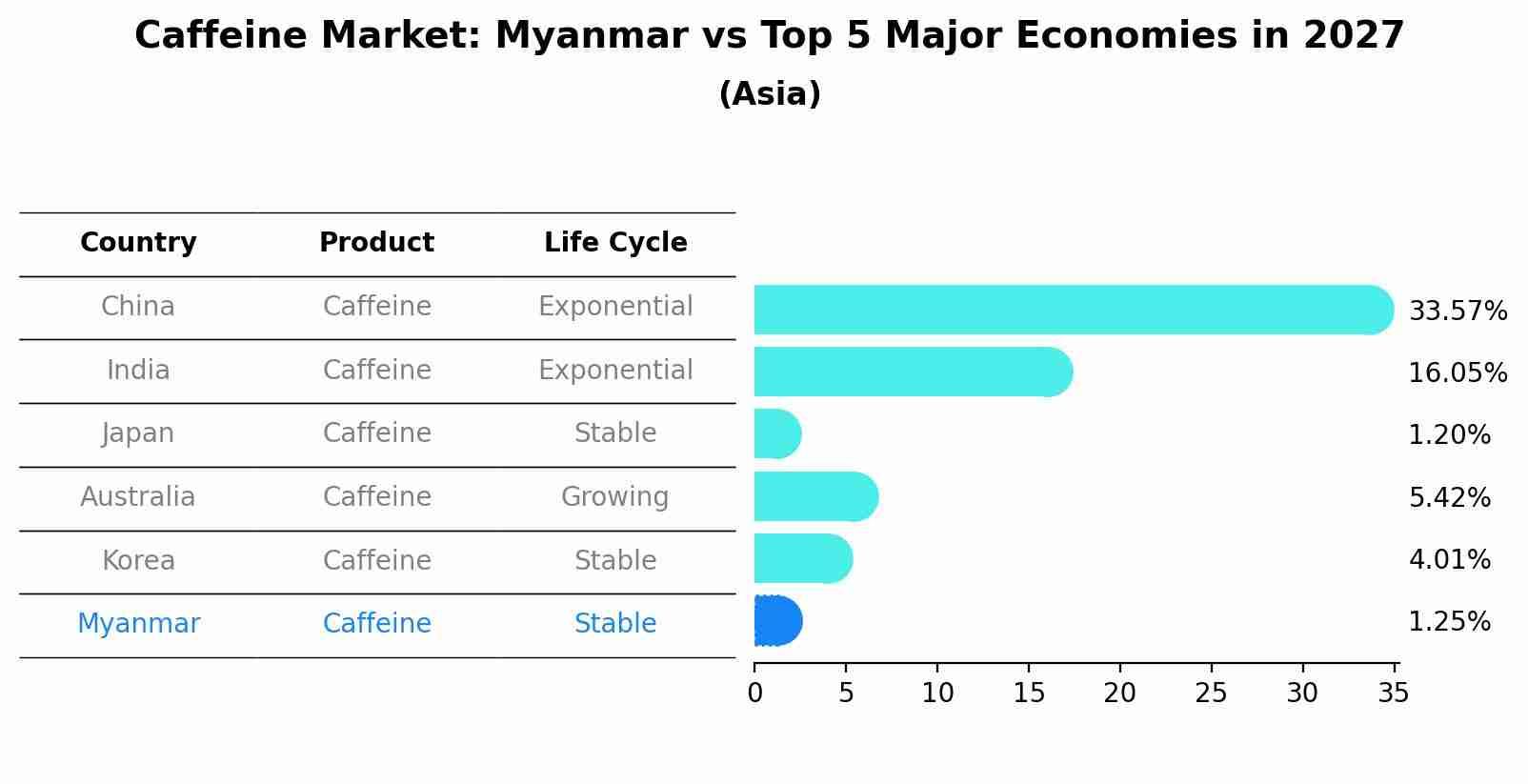Myanmar Caffeine Market (2025-2031) Outlook | Growth, Analysis, Industry, Value, Forecast, Share, Size, Companies, Trends, Revenue
| Product Code: ETC110033 | Publication Date: Jun 2021 | Updated Date: Apr 2025 | Product Type: Report | |
| Publisher: 6Wresearch | Author: Ravi Bhandari | No. of Pages: 70 | No. of Figures: 35 | No. of Tables: 5 |
Myanmar Caffeine Market Size Growth Rate
The Myanmar Caffeine Market is projected to witness mixed growth rate patterns during 2025 to 2029. The growth rate begins at -0.94% in 2025, climbs to a high of 2.56% in 2028, and moderates to 1.30% by 2029.

Caffeine Market: Myanmar vs Top 5 Major Economies in 2027 (Asia)
The Caffeine market in Myanmar is projected to grow at a stable growth rate of 1.25% by 2027, within the Asia region led by China, along with other countries like India, Japan, Australia and South Korea, collectively shaping a dynamic and evolving market environment driven by innovation and increasing adoption of emerging technologies.

Myanmar Caffeine Market Overview
The Myanmar caffeine market is primarily driven by its use in the food and beverage industry, particularly in coffee, tea, and energy drinks. Growing consumer preference for caffeinated products and the influence of global trends are supporting market growth. Additionally, the pharmaceutical industrys demand for caffeine as an ingredient in pain relief medications further contributes to the market.
Drivers of the market
The caffeine market in Myanmar is propelled by its widespread use in food and beverages, pharmaceuticals, and cosmetics. The growing popularity of energy drinks and caffeinated beverages among the young population drives the market. Additionally, the increasing consumption of coffee and tea, along with rising disposable incomes, boosts the demand for caffeine. The pharmaceutical industry`s expansion, driven by increasing healthcare needs, also contributes to market growth, as caffeine is used in various medications for its stimulant properties.
Challenges of the market
The caffeine market in Myanmar is challenged by limited consumer awareness and cultural preferences. Caffeine consumption, often associated with coffee and energy drinks, is not deeply ingrained in the local culture, which favors traditional beverages like tea. This cultural preference limits the potential market size for caffeine-containing products. Moreover, the absence of large-scale local production of caffeine and related products necessitates imports, which can be expensive and logistically challenging. Marketing efforts to increase consumer awareness and shift cultural preferences are essential but difficult to implement effectively.
Government Policy of the market
In Myanmar, government regulations regarding food and beverage additives, including caffeine, are aimed at ensuring consumer safety and product quality. Policies concerning labeling, advertising, and maximum allowable limits of caffeine in products contribute to shaping the caffeine market in Myanmar.
Key Highlights of the Report:
- Myanmar Caffeine Market Outlook
- Market Size of Myanmar Caffeine Market, 2024
- Forecast of Myanmar Caffeine Market, 2031
- Historical Data and Forecast of Myanmar Caffeine Revenues & Volume for the Period 2021-2031
- Myanmar Caffeine Market Trend Evolution
- Myanmar Caffeine Market Drivers and Challenges
- Myanmar Caffeine Price Trends
- Myanmar Caffeine Porter's Five Forces
- Myanmar Caffeine Industry Life Cycle
- Historical Data and Forecast of Myanmar Caffeine Market Revenues & Volume By Type for the Period 2021-2031
- Historical Data and Forecast of Myanmar Caffeine Market Revenues & Volume By Natural Caffeine for the Period 2021-2031
- Historical Data and Forecast of Myanmar Caffeine Market Revenues & Volume By Synthetic Caffeine for the Period 2021-2031
- Historical Data and Forecast of Myanmar Caffeine Market Revenues & Volume By Applications for the Period 2021-2031
- Historical Data and Forecast of Myanmar Caffeine Market Revenues & Volume By Pharmaceuticals for the Period 2021-2031
- Historical Data and Forecast of Myanmar Caffeine Market Revenues & Volume By Food for the Period 2021-2031
- Historical Data and Forecast of Myanmar Caffeine Market Revenues & Volume By Beverages for the Period 2021-2031
- Historical Data and Forecast of Myanmar Caffeine Market Revenues & Volume By Flavours and Fragrances for the Period 2021-2031
- Myanmar Caffeine Import Export Trade Statistics
- Market Opportunity Assessment By Type
- Market Opportunity Assessment By Applications
- Myanmar Caffeine Top Companies Market Share
- Myanmar Caffeine Competitive Benchmarking By Technical and Operational Parameters
- Myanmar Caffeine Company Profiles
- Myanmar Caffeine Key Strategic Recommendations
Frequently Asked Questions About the Market Study (FAQs):
- Single User License$ 1,995
- Department License$ 2,400
- Site License$ 3,120
- Global License$ 3,795
Search
Thought Leadership and Analyst Meet
Our Clients
Related Reports
- Afghanistan Apparel Market (2026-2032) | Growth, Outlook, Industry, Segmentation, Forecast, Size, Companies, Trends, Value, Share, Analysis & Revenue
- Canada Oil and Gas Market (2026-2032) | Share, Segmentation, Value, Industry, Trends, Forecast, Analysis, Size & Revenue, Growth, Competitive Landscape, Outlook, Companies
- Germany Breakfast Food Market (2026-2032) | Industry, Share, Growth, Size, Companies, Value, Analysis, Revenue, Trends, Forecast & Outlook
- Australia Briquette Market (2025-2031) | Growth, Size, Revenue, Forecast, Analysis, Trends, Value, Share, Industry & Companies
- Vietnam System Integrator Market (2025-2031) | Size, Companies, Analysis, Industry, Value, Forecast, Growth, Trends, Revenue & Share
- ASEAN and Thailand Brain Health Supplements Market (2025-2031) | Strategy, Consumer Insights, Analysis, Investment Trends, Opportunities, Growth, Size, Share, Industry, Revenue, Segments, Value, Segmentation, Supply, Forecast, Restraints, Outlook, Competition, Drivers, Trends, Demand, Pricing Analysis, Competitive, Strategic Insights, Companies, Challenges
- ASEAN Bearings Market (2025-2031) | Strategy, Consumer Insights, Analysis, Investment Trends, Opportunities, Growth, Size, Share, Industry, Revenue, Segments, Value, Segmentation, Supply, Forecast, Restraints, Outlook, Competition, Drivers, Trends, Demand, Pricing Analysis, Competitive, Strategic Insights, Companies, Challenges
- Europe Flooring Market (2025-2031) | Outlook, Share, Industry, Trends, Forecast, Companies, Revenue, Size, Analysis, Growth & Value
- Saudi Arabia Manlift Market (2025-2031) | Outlook, Size, Growth, Trends, Companies, Industry, Revenue, Value, Share, Forecast & Analysis
- Uganda Excavator, Crane, and Wheel Loaders Market (2025-2031) | Strategy, Consumer Insights, Analysis, Investment Trends, Opportunities, Growth, Size, Share, Industry, Revenue, Segments, Value, Segmentation, Supply, Forecast, Restraints, Outlook, Competition, Drivers, Trends, Demand, Pricing Analysis, Competitive, Strategic Insights, Companies, Challenges
Industry Events and Analyst Meet
Whitepaper
- Middle East & Africa Commercial Security Market Click here to view more.
- Middle East & Africa Fire Safety Systems & Equipment Market Click here to view more.
- GCC Drone Market Click here to view more.
- Middle East Lighting Fixture Market Click here to view more.
- GCC Physical & Perimeter Security Market Click here to view more.
6WResearch In News
- Doha a strategic location for EV manufacturing hub: IPA Qatar
- Demand for luxury TVs surging in the GCC, says Samsung
- Empowering Growth: The Thriving Journey of Bangladesh’s Cable Industry
- Demand for luxury TVs surging in the GCC, says Samsung
- Video call with a traditional healer? Once unthinkable, it’s now common in South Africa
- Intelligent Buildings To Smooth GCC’s Path To Net Zero


















